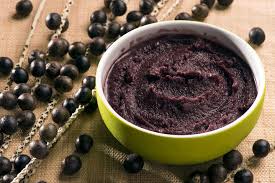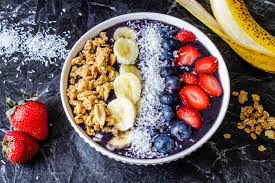Exploring the Irresistible Delights of the Açaí Bowl
The Delicious and Nutritious Açaí Bowl
Originating from the Amazon rainforest in Brazil, the açaí bowl has taken the health food world by storm. This tasty and nutritious dish is not only a treat for your taste buds but also packs a powerful punch of antioxidants and essential nutrients.
The base of an açaí bowl is made from frozen açaí berries, which are blended into a thick and creamy consistency. This superfood is known for its high levels of antioxidants that help fight inflammation and promote overall well-being.
Typically topped with an assortment of fresh fruits, nuts, seeds, granola, and honey, the açaí bowl offers a delightful mix of flavors and textures. It’s not only delicious but also incredibly versatile – you can customize your toppings to suit your preferences and dietary needs.
Whether enjoyed as a refreshing breakfast or a satisfying snack, the açaí bowl is sure to leave you feeling nourished and energized. So next time you’re looking for a healthy and delicious treat, consider indulging in the vibrant colors and flavors of an açaí bowl!
6 Tips for Crafting the Perfect Açai Bowl: A Delicious and Nutritious Guide
- Blend frozen açai with other fruits for a thicker consistency.
- Top your açai bowl with a variety of fresh fruits for added flavor and nutrients.
- Add granola or nuts for some crunch and texture.
- Drizzle honey or agave nectar for a touch of sweetness.
- Incorporate chia seeds or flaxseeds for an extra nutritional boost.
- Enjoy your açai bowl as a refreshing and nutritious breakfast or snack.
Blend frozen açai with other fruits for a thicker consistency.
To enhance the texture of your açaí bowl, consider blending frozen açai with other fruits. This simple tip can result in a thicker consistency that is both satisfying and delicious. By combining açai with fruits like bananas, berries, or mangoes, you can create a smooth and creamy base that elevates the overall flavor profile of your bowl. Experimenting with different fruit combinations allows you to customize your açaí bowl to suit your preferences while adding an extra boost of nutrients and natural sweetness.
Top your açai bowl with a variety of fresh fruits for added flavor and nutrients.
Enhance your açaí bowl experience by generously topping it with a colorful assortment of fresh fruits. Not only does this add a burst of flavor to each bite, but it also boosts the nutritional value of your meal. The combination of vibrant fruits not only makes your bowl visually appealing but also provides a variety of essential vitamins, minerals, and antioxidants that contribute to your overall health and well-being. So go ahead and get creative with your fruit toppings to elevate your açaí bowl into a delicious and nutrient-packed treat!
Add granola or nuts for some crunch and texture.
Enhance your açaí bowl experience by adding a generous sprinkle of crunchy granola or nuts. This simple tip not only adds a delightful textural contrast to the creamy base but also introduces a satisfying crunch that elevates the overall enjoyment of your bowl. The combination of smooth açaí, fresh fruits, and crunchy toppings creates a harmonious balance of flavors and textures that will leave your taste buds craving more.
Drizzle honey or agave nectar for a touch of sweetness.
To enhance the flavor of your açaí bowl, consider drizzling a bit of honey or agave nectar over the top for a touch of natural sweetness. These sweeteners not only add a delicious taste but also complement the tartness of the açaí berries, creating a well-balanced and satisfying treat. Whether you prefer the rich flavor of honey or the lighter sweetness of agave nectar, this simple tip can elevate your açaí bowl to a whole new level of enjoyment.
Incorporate chia seeds or flaxseeds for an extra nutritional boost.
For an extra nutritional boost in your açaí bowl, consider incorporating chia seeds or flaxseeds. These tiny seeds are packed with essential nutrients like omega-3 fatty acids, fiber, and antioxidants. By adding chia seeds or flaxseeds to your açaí bowl, you not only enhance its texture and flavor but also increase its health benefits. Sprinkle a generous amount of these super seeds on top of your bowl to elevate its nutritional value and add a delightful crunch to each bite.
Enjoy your açai bowl as a refreshing and nutritious breakfast or snack.
For a delightful and nourishing start to your day or a satisfying pick-me-up, savor your açaí bowl as a refreshing and nutritious breakfast or snack. Its vibrant flavors and wholesome ingredients make it a perfect choice to fuel your body and satisfy your taste buds. Whether you’re looking for a quick energy boost in the morning or a delicious treat in the afternoon, an açai bowl is sure to hit the spot.





